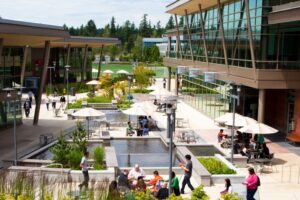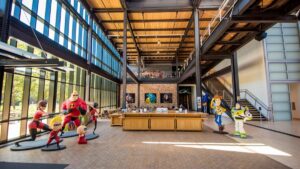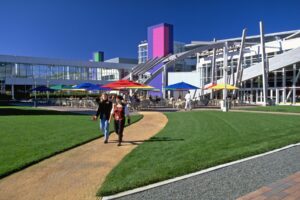As work evolves, it’s crucial to understand the new paradigms shaping our workplaces. Welcome back to our Unworking Weekly mini-series, inspired by the new book “Unworking: The Reinvention of the Modern Office” by Philip Ross & Jeremy Myerson.
Over the next twelve weeks, we will explore the themes of each chapter, offering insights into the book’s vision for the future of work and the workplace. For the past century, offices have been integral to society, influencing everything from city architecture to daily routines. However, the pandemic triggered a reevaluation of the office’s role, promoting a shift away from outdated practices.
Each chapter of Unworking explores the various facets of the evolving workplace landscape. For the second installation of our series, we look at Chapter 2: Community. This chapter takes us on a journey through the evolution of office design, from traditional layouts to community-oriented workplaces.
Community, in the context of work and workplace, refers to a collaborative and interconnected environment where individuals share common goals, values, and spaces.
It involves not only physical proximity but also social interactions, mutual support, and a sense of belonging. A community-oriented workplace prioritises diversity, inclusivity, employee engagement, and empowerment, as well as the cultivation of relationships to enhance productivity, creativity, a good workplace culture, and overall well-being.
The Evolution of Community-Oriented Workplaces.
Community-oriented workplaces have undergone a significant evolution, driven by the need to create environments that prioritise collaboration, innovation, and employee well-being.
Historically, the concept of community in office design traces back to revolutionary ideas like Burolandschaft, which emerged in Germany in the late 1950s. This concept emphasised flexible and democratic spaces, moving away from strict hierarchies of traditional office layouts. This approach laid the foundation for modern office spaces designed to foster a sense of community among employees.
One example of this evolution is the Microsoft Campus in Redmond, Washington. Microsoft’s commitment to community-oriented design principles is shown through the layout of its campus, which includes a diverse range of communal spaces that have been integrated throughout the grounds. These spaces are designed to encourage spontaneous interactions and collaboration among employees from different departments and specialties. By prioritising interdisciplinary collaboration and employee wellbeing, workplaces like the Microsoft Campus show us how international design can cultivate buzzing workplace cultures conducive to creativity, innovation, and collaboration.

Microsoft Campus in Redmond, Washington.
Fostering Collaboration and the Power of Serendipity.
Studies show that collaborative work environments not only enhance employee satisfaction but also drive innovation and creativity. According to a report by Harvard Business Review, companies with collaborative workplaces are five times more likely to be high-performing. Research by the University of Michigan found that collaborative work environments can improve performance by up to 15%. Incorporating community-oriented design principles can lead to a more vibrant and productive workplace culture.
The Pixar campus, designed to encourage unexpected encounters among employees, highlights how these environments can inspire innovative ideas and foster collaboration. Pixar’s headquarters in Emeryville, California, designed under the guidance of Steve Jobs, features an open atrium that serves as a central hub. This space includes a cafeteria, meeting rooms, and informal spaces, placed intentionally to create opportunities for spontaneous collisions between employees from different departments, leading to creative ideas and innovations. The design also includes a town square concept, with shared spaces to encourage employees to get up and leave their desks to engage with each other, further fostering a sense of community and collaboration.

Pixar’s headquarters in Emeryville, California
We recently held a Future of the Legal Workplace Symposium, where the Managing Director of Baker McKenzie said one of his favorite parts about their office’s redesign was the ‘spontaneous collisions’ employees were having in their common areas. These serendipitous interactions in the workplace can often lead to unexpected breakthroughs and solutions. In a Harvard Business Review study, it was found that 70% of employees believe chance encounters at work improve their quality of life. By designing offices that facilitate these spontaneous interactions, organizations can harness the power of serendipity to foster creativity and problem-solving.
Google’s campus in Mountain View, California, known as the Googleplex, is an excellent example of a workplace designed to encourage serendipitous interactions. The Googleplex features open spaces, communal areas, and a variety of amenities, including cafes, lounges, and recreational facilities. These spaces are placed with the intention of encouraging employees to move around the campus, thus increasing the likelihood of spontaneous meetings. The environment supports a culture of innovation, where employees from different teams and specialties can easily exchange ideas and brainstorm on both individual and collaborative projects.

Google’s campus in Mountain View, California.
The discussion highlights the evolution of community in contemporary workplaces, emphasising its crucial role in shaping organisational culture and fostering collaboration. As the concept of community continues to evolve, organisations are challenged to create environments that prioritise diversity, inclusivity, and employee engagement while enhancing productivity and well-being.
Readers can dive deeper into the exploration of community-oriented workplace design and its impact on the future of work in Philip Ross and Jeremy Myerson’s latest book, Unworking: The Reinvention of the Modern Office. By understanding the evolution of community in the workplace, we can adapt and innovate, creating dynamic environments that inspire creativity, innovation, and collaboration.
Grab your copy of Unworking from Amazon here.

